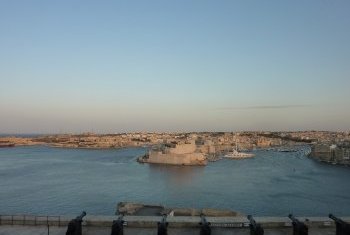Caspar Dechmann 1
Knights Fortifications Around The Harbours Of Malt
Knights Fortifications around the Harbours of Malt (On tentative list)

There is no doubt that his should have been part of the Valletta inscription from the start. While the inscribed town is very nice, it is certainly not as spectacular as the former, older seat of the Order of St. John in Rhodos. While there are many must-visits in Valletta, such as the Archeological and the Art Museum, the Grandmasters House, Fort St. Elmo and several churches full of remarkable art, there is no single building in Valletta with real OUV. It is mainly the stunning townscape with the two bays, the fortifications and the many church towers and large domes that make this an unforgettable place. The question, that is not clearly answered in the nomination, is which parts of the metropolis around the two bays should be included into an extended core zone that makes more sense then the current Valletta inscription. Today the large area around the two bays consists of many separate towns but for the visitor it is just one large continuous metropolis. Unfortunately Malta has very little building regulations and a lot of the buildings, especially on the western bay are of deplorable aesthetic quality and if it were situated in central Europe Valletta would have lost its WHS for a long time because of the ruined vistas.
But in the Eastern bay you have the two peninsulas of Birgu and Senglea that are both older then Valletta: Birgu has a wonderful, meandering medieaval townscape that contrasts strongly with the younger city of Valletta with its baroque chessboard plan. The tip of the Birgu seems to have been populated continuesly for thousands of years, since the pheniciens. Today you find here Fort Angelo, going back to around 1200, possibly to Friedrich II of Swabia who left so much in Sicily and the South of Italy. The fort that you can visit today is mainly younger but still shows many centuries of history. This position seems to have been the key to control this important natural harbour and therewith to the control of the whole island. When the knights came to Malta after being expulsed from Rhodes they made there first seat in Pirgu and its fort, and in the old town you find, as in Rhodes and Valletta, many old palaces belonging to the various groups of the order.
The neighbouring peninsula of Senglea is also older then Valletta and has huge early fortifications. Between the two peninsulas you find the first dockyard of Malta, a key function for the seafaring knights. Both towns have steep and splendid townscapes that remind a bit of fantastic towns depictions by Piranesi or M.C. Escher. A bit later the fortifications of the two peninsulas was again extended to the East with a large ring of walls, the Cottonera lines, much of which you can still see today. Most impressive in the huge Notre Dame Gate.
To the north of the two peninsulas there are two more peninsulas: on the third, Kalkara, you find classicist museum building of a later date and little remnants of the former fortifications but on the last peninsula you have another huge fort: Fort Rikasoli, which is closed for visitors.
To the south of Valletta you find the late baroque extension of Florinana with huge fortifications: Its central avenue is surrounded by great buildings and should be part of the extension together with the fortifications.
The towns of the western bay are of a later date and here only the large island with Fort Manoel should be included as a counterpart to Fort Angelo in the other bay. It is closed for visitors but you can walk around the complex and enjoy the splendid views on Valletta.
The most northern western peninsula has a small fort, Fort Tigné, probably from the 19th century and should be left to the buffer zone. It also closed to visitors and surrounded by expensive looking but painfully unfitting buildings. A walk around the surrounding rocks and the views on Valletta and the bay are still worth a visit.
If you visit the Art Museum in Valletta and the Museum of War in Fort St. Elmo in Valletta, both a must for any visitor to Malta, you find nice paintings and engravings of the harbour area from different times of its development. To me depictions from the beginning of 18th century seem to be the best guide if you want to see what should be included in the core zone: They show the peak of the knights’ development of the city with the fortresses around the eastern bay, Fort Manoel and the Floriana extension to the south. Probably all the fortifications have been altered or extended later by the British but there basic layout and much of the older substance seems preserved.
Comments
No comments yet.
